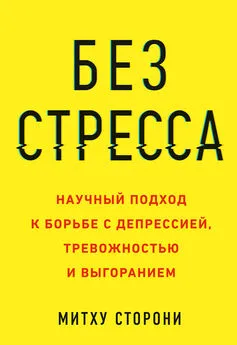Митху Сторони - Без стресса. Научный подход к борьбе с депрессией, тревожностью и выгоранием
- Название:Без стресса. Научный подход к борьбе с депрессией, тревожностью и выгоранием
- Автор:
- Жанр:
- Издательство:Литагент МИФ без БК
- Год:2019
- Город:Москва
- ISBN:978-5-00117-633-6
- Рейтинг:
- Избранное:Добавить в избранное
-
Отзывы:
-
Ваша оценка:
Митху Сторони - Без стресса. Научный подход к борьбе с депрессией, тревожностью и выгоранием краткое содержание
На русском языке публикуется впервые.
Без стресса. Научный подход к борьбе с депрессией, тревожностью и выгоранием - читать онлайн бесплатно ознакомительный отрывок
Интервал:
Закладка:
239
Y. Aguilera, M. Rebollo-Hernanz, T. Herrera, L. T. Cayuelas, P. Rodríguez-Rodríguez, Á. L. de Pablo, S. M. Arribas, and M. A. Martin-Cabrejas, «Intake of Bean Sprouts Influences Melatonin and Antioxidant Capacity Biomarker Levels in Rats». Food & Function 7, no. 3 (Mar. 2016): 1438–1445.
240
G. Howatson, P. G. Bell, J. Tallent, B. Middleton, M. P. McHugh, and J. Ellis, «Effect of Tart Cherry Juice (Prunus cerasus) on Melatonin Levels and Enhanced Sleep Quality». European Journal of Nutrition (2012): 909–916.
241
Это не шутка – такое исследование действительно проводилось.
242
A. Asher, A. Shabtay, A. Brosh, H. Eitam, R. Agmon, M. CohenZinder, A. E. Zubidat, and A. Haim, «‘Chrono-functional Milk’: The Difference between Melatonin Concentrations in Night-milk versus Day-milk under Different Night Illumination Conditions». Chronobiology International 32, no. 10 (2015): 1409–1416.
243
R. H. Goo, J. G. Moore, E. Greenberg, et al., «Circadian Variation in Gastric Emptying of Meals in Humans». Gastroenterology 93 (1987): 515–518.
244
S. S. Rao, P. Sadeghi, J. Beaty, et al., «Ambulatory 24-h Colonic Manometry in Healthy Humans». American Journal of Physiology: Gastrointestinal and Liver Physiology 280 (2001): G629–G639.
245
S. S. Han, R. Zhang, R. Jain, et al., «Circadian Control of Bile Acid Synthesis by a Klf15-fgf15 Axis». Nature Communications 6 (2015): 7231.
246
A. Zarrinpar, A. Chaix, S. Yooseph, et al., «Diet and Feeding Pattern Affect the Diurnal Dynamics of the Gut Microbiome». Cell Metabolism 20 (2014): 1006–1017.
247
J. Lund, J. Arendt, S. M. Hampton, J. English, and L. M. Morgan, «Postprandial Hormone and Metabolic Responses amongst Shift Workers in Antarctica». Journal of Endocrinology 171, no. 3 (Dec. 2001): 557–564.
248
P. Rubio-Sastre, F. A. Scheer, P. Gómez-Abellán, J. A. Madrid, and M. Garaulet, «Acute melatonin administration in humans impairs glucose tolerance in both the morning and evening». Sleep 37, no. 10 (Oct. 2014): 1715–1719.
249
C. Vollmers, S. Gill, L. DiTacchio, S. R. Pulivarthy, H. D. Le, and S. Panda, «Time of Feeding and the Intrinsic Circadian Clock Drive Rhythms in Hepatic Gene Expression». Proceedings of the National Academy of Sciences of the United States of America 106, no. 50 (Dec. 2009): 21453–21458.
250
A. Hirao, H. Nagahama, T. Tsuboi, M. Hirao, Y. Tahara, and S. Shibata, «Combination of Starvation Interval and Food Volume Determines the Phase of Liver Circadian Rhythm in Per2: Luc Knock-in Mice under Two Meals per Day Feeding». American Journal of Physiology-Gastrointestinal and Liver Physiology 299, no. 5 (2010): G1045–1053.
251
H. Kuroda, Y. Tahara, K. Saito, N. Ohnishi, Y. Kubo, Y. Seo, et al., «Meal Frequency Patterns Determine the Phase of Mouse Peripheral Circadian Clocks». Scientific Reports 2 (2012): 711.
252
R. Hara, K. Wan, H. Wakamatsu, R. Aida, T. Moriya, M. Akiyama, et al., «Restricted Feeding Entrains Liver Clock without Participation of the Suprachiasmatic Nucleus». Genes to Cells 6, no. 3 (2001): 269–278.
253
T. Yoshizaki, Y. Tada, A. Hida, A. Sunami, Y. Yokoyama, J. Yasuda, Nakai, F. Togo, and Y. Kawano, «Effects of Feeding Schedule Changes on the Circadian Phase of the Cardiac Autonomic Nervous System and Serum Lipid Levels». European Journal of Applied Physiology 113, no. 10 (Oct. 2013): 2603–2611.
254
C. Bandín, F. A. Scheer, A. J. Luque, V. Avila-Gandía, S. Zamora, J. A. Madrid, P. Gómez-Abellán, and M. Garaulet, «Meal Timing Affects Glucose Tolerance, Substrate Oxidation and Circadianrelated Variables: A Randomized, Crossover Trial». International Journal of Obesity 39, no. 5 (May 2015): 828–833.
255
M. Hatori, C. Vollmers, A. Zarrinpar, L. DiTacchio, E. A. Bushong, S. Gill, M. Leblanc, A. Chaix, M. Joens, J. A. Fitzpatrick, M. H. Ellisman, and S. Panda, «Time-restricted Feeding without Reducing Caloric Intake Prevents Metabolic Diseases in Mice Fed a High-fat Diet». Cell Metabolism 15, no. 6 (Jun. 2012): 848–860.
256
D. Jakubowicz, M. Barnea, J. Wainstein, et al., «High Caloric Intake at Breakfast vs. Dinner Differentially Influences Weight Loss of Overweight and Obese Women». Obesity 21 (2013): 2504–2512.
257
Y. Yamanaka, S. Hashimoto, N. N. Takasu, Y. Tanahashi, S. Y. Nishide, S. Honma, and K. Honma, «Morning and Evening Physical Exercise Differentially Regulate the Autonomic Nervous System during Nocturnal Sleepin Humans». American Journalof Physiology – Regulatory, Integrative and Comparative Physiology 309, no. 9 (Nov. 2015): R1112–1121.
258
M. R. Ebben and A. J. Spielman, «The Effects of Distal Limb Warming on Sleep Latency». International Journal of Behavioral Medicine 13, no. 3 (2006): 221–228.
259
T. M. Burke, R. R. Markwald, A. W. McHill, E. D. Chinoy, J. A. Snider, S. C. Bessman, C. M. Jung, J. S. O’Neill, and K. P. Wright Jr., «Effects of Caffeine on the Human Circadian Clock in vivo and in vitro». Science Translational Medicine 7, no. 305 (Sept. 2015): 305ra146.
260
http://www.mayoclinic.org/healthylifestyle/nutritionand-healthy-eating/in-depth/caffeine/art-20045678.
261
H. Slama, G. Deliens, R. Schmitz, P. Peigneux, and R. Leproult, «Afternoon Nap and Bright Light Exposure Improve Cognitive Flexibility Post Lunch». PLoS ONE10 , no. 5 (May 2015): e0125359.
262
H. Baek and B. K. Min, «Blue Light Aids in Coping with the Postlunch Dip: An EEG Study». Ergonomics 58, no. 5 (2015): 803–810.
263
M. Takahashi and H. Arito, «Maintenance of Alertness and Performance by a Brief Nap after Lunch under Prior Sleep Deficit». Sleep 23, no. 6 (Sept. 2000): 813–819.
264
M. Takahashi, H. Fukuda, and H. Arito, «Brief Naps during Postlunch Rest: Effects on Alertness, Performance, and Autonomic Balance». European Journal of Applied Physiology and Occupational Physiology 78, no. 2 (Jul. 1998): 93–98.
265
J. A. Groeger, J. C. Lo, C. G. Burns, and D. J. Dijk, «Effects of Sleep Inertia after Daytime Naps Vary with Executive Load and Time of Day». Behavioral Neuroscience 125, no. 2 (Apr. 2011): 252–260.
266
M. Tamaki, A. Shirota, M. Hayashi, and T. Hori, «Restorative Effects of a Short Afternoon Nap (<30 min) in the Elderly on Subjective Mood, Performance and EEG Activity». Sleep Research Online 3 (2000): 131–139.
267
K. Müller, L. Libuda, A. M. Terschlüsen, and M. Kersting, «A Review of the Effects of Lunch on Adults’ Short-term Cognitive Functioning». Canadian Journal of Dietetic Practice and Research 74, no. 4 (2013): 181–188.
268
L. A. Reyner, S. J. Wells, V. Mortlock, and J. A. Horne, «‘Post-lunch’ Sleepiness during Prolonged, Monotonous Driving – Effects of Meal Size». Physiology & Behavior 105, no. 4 (Feb. 2012): 1088–1091.
269
L. V. Borovikova, S. Ivanova, M. Zhang, H. Yang, G. I. Botchkina, L. R. Watkins, H. Wang, N. Abumrad, J. W. Eaton, and K. J. Tracey, «Vagus Nerve Stimulation Attenuates the Systemic Inflammatory Response to Endotoxin». Nature 405 (2000): 458–462.
270
L. V. Borovikova, S. Ivanova, M. Zhang, H. Yang, G. I. Botchkina, L. R. Watkins, H. Wang, N. Abumrad, J. W. Eaton, and K. J. Tracey, «Vagus Nerve Stimulation Attenuates the Systemic Inflammatory Response to Endotoxin». Nature 405 (2000): 458–462.
271
J. A. Sturgeon, A. Arewasikporn, M. A. Okun, M. C. Davis, A. D. Ong, and A. J. Zautra, «The Psychosocial Context of Financial Stress: Implications for Inflammation and Psychological Health». Psychosomatic Medicine 78, no. 2 (Nov. 2015): 134–143.
272
G. E. Miller, E. Chen, J. Sze, T. Marin, J. M. Arevalo, R. Doll, et al., «A Functional Genomic Fingerprint of Chronic Stress in Humans: Blunted Glucocorticoid and Increased NF-kappaB Signaling». Biological Psychiatry 64 (2008): 266–272.
273
Z. Visnovcova, D. Mokra, P. Mikolka, M. Mestanik, A. Jurko, M. Javorka, A. Calkovska, and I. Tonhajzerova, «Alterations in Vagalimmune Pathway in Long-lasting Mental Stress». Advances in Experimental Medicine and Biology 832 (2015): 45–50.
274
H. Besedovsky, A. del Rey, E. Sorkin, and C. A. Dinarello, «Immunoregulatory Feedback between Interleukin-1 and Glucocorticoid Hormones». Science 233, no. 4764 (Aug. 1986): 652–654.
275
When your immune system detects invading viruses and bacteria, it releases inflammatory agents. One such agent is interleukin-1 or IL-1. IL-1 triggers the release of the stress hormone cortisol by setting off a chain of commands along the stress axis.
276
R. Dantzer, J. C. O’Connor, G. G. Freund, R. W. Johnson, and K. W. Kelley, «From Inflammation to Sickness and Depression: When the Immune System Subjugates the Brain». Nature Reviews Neuroscience 9, no. 1 (Jan. 2008): 46–56.
277
P. W. Gold, «The Organization of the Stress System and its Dysregulation in Depressive Illness». Molecular Psychiatry 20, no. 1 (Feb. 2015): 32–47.
278
T. W. Pace, F. Hu, and A. H. Miller, «Cytokine-effects on Glucocorticoid Receptor Function: Relevance to Glucocorticoid Resistance and the Pathophysiology and Treatment of Major Depression». Brain, Behavior, and Immunity 21 (2007): 9–19.
279
C. L. Raison and A. H. Miller, «When Not Enough is Too Much: The Role of Insufficient Glucocorticoid Signaling in the Pathophysiology of Stress-related Disorders». American Journal of Psychiatry 160 (2003): 1554–1565.
280
A. Bierhaus, J. Wolf, M. Andrassy, et al., «A Mechanism Converting Psychosocial Stress into Mononuclear Cell Activation». Proceedings of the National Academy of Sciences of the United States of America 100, no. 4 (2003): 1920–1925.
281
M. Iwata, K. T. Ota, X. Y. Li, F. Sakaue, N. Li, S. Dutheil, M. Banasr, V. Duric, T. Yamanashi, K. Kaneko, K. Rasmussen, A. Glasebrook, A. Koester, D. Song, K. A. Jones, S. Zorn, G. Smagin, and R. S. Duman, «Psychological Stress Activates the Inflammasome via Release of Adenosine Triphosphate and Stimulation of the Purinergic Type 2X7 Receptor». Biological Psychiatry 80, no. 1 (Dec. 2015): 12–22.
282
Y. Zhang, L. Liu, Y. Z. Liu, X. L. Shen, T. Y. Wu, T. Zhang, W. Wang, Y. X. Wang, and C. L. Jiang, «NLRP3 Inflammasome Mediates Chronic Mild Stress-Induced Depression in Mice via Neuroinflammation». International Journal of Neuropsychopharmacology 18, no. 8 (Jan. 2015), pii: pyv006.
Читать дальшеИнтервал:
Закладка:









